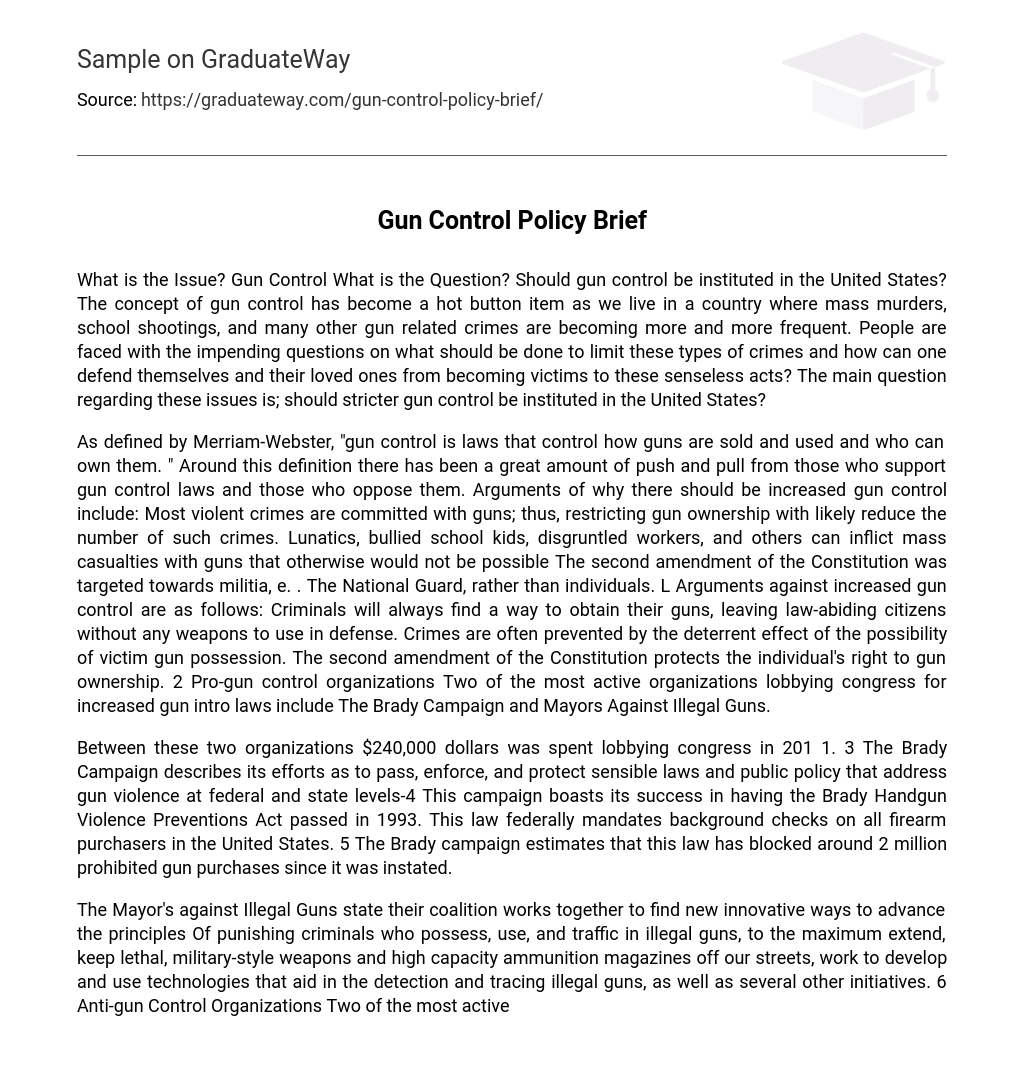The topic of gun control in the United States is a subject of intense debate as a result of the rising incidents of mass killings, school shootings, and other crimes involving firearms. There is a pressing need to find ways to prevent these tragic acts and ensure the safety of individuals and their families. The central issue revolves around whether more stringent measures should be implemented for regulating guns.
Gun control, as defined by Merriam-Webster, pertains to laws governing the sale, use, and ownership of firearms. This definition has ignited a debate between supporters and detractors of gun control. Supporters claim that enacting these laws would decrease violent crimes involving guns and deter mass shootings perpetrated by individuals with malicious intent. Conversely, opponents argue that criminals will always find means to acquire guns, leaving law-abiding citizens vulnerable. They also contend that the second amendment of the Constitution guarantees an individual’s right to possess firearms. Two influential organizations actively lobbying Congress for stricter gun control legislation include the Brady Campaign and Mayors Against Illegal Guns.
In 2011, the Brady Campaign and another organization combined to spend $240,000 on lobbying congress. The main goal of the Brady Campaign is to pass, enforce, and protect sensible laws and public policies that deal with gun violence at both federal and state levels. They are proud of their accomplishment in getting the Brady Handgun Violence Preventions Act passed into law in 1993. This act requires background checks for all individuals buying firearms nationwide. According to estimates from the Brady campaign, this law has effectively stopped around 2 million illegal gun purchases since it was put into effect.
The Mayor’s against Illegal Guns coalition works together to discover new methods of promoting the principles of punishing criminals who possess, use, and traffic in illegal guns as much as possible. Their objective is to prevent easy access to lethal, military-style weapons and high capacity ammunition magazines on our streets. They also strive to create and employ technologies that assist in identifying and tracking illegal guns. The coalition has other initiatives too. Six organizations actively oppose gun-control laws, with the National Rifle Association (NORA) and Gun Owners of America (GAO) being the most prominent ones.
Both the NORA-ILL (Institute for Legislative Action) and Gun Owners of America (GAO) focused on lobbying Congress in 2011. The NORA-ILL branch is dedicated to firearms ownership and use issues. They oppose restrictive gun control legislation, support pro-gun reform legislation, and aim to educate the public about gun ownership. GAO, established in 1975, is a non-profit organization that advocates for preserving and defending the Second Amendment rights of gun owners. They are known as the only ‘no compromise’ gun lobbying group and also engage in nationwide court battles to protect these rights. Currently, there are ongoing discussions regarding two main types of gun control: reforming gun policy and implementing total gun-control.
Many ordinary citizens often mistake reform policy and total gun control as being the same, but they are actually quite distinct. Reform policy aims to address existing gun laws, while total gun control is often perceived as the government completely confiscating all firearms or severely restricting the types of guns civilians can own. There appears to be widespread support for reform gun policy, including from organizations like NORA, which opposes total gun control. Current gun control policies generally focus on one or more of four broad objectives. These laws seek to: 1. Establish conditions that prohibit certain individuals from possessing firearms; 2.
Introduce regulations to prevent individuals who are prohibited from owning firearms from doing so, limit the carrying of concealed firearms outside the home, and regulate firearm design for enhanced public and personal safety. The aim of policy reform is to reinforce current laws and address loopholes that enable prohibited individuals to easily buy firearms as per federal law. Comprehensive gun control is often perceived as a complete prohibition on civilian possession of firearms and stringent restrictions on specific types of firearms permitted for civilian use.
The strict gun restrictions implemented in specific cities, such as Washington DC and Chicago, have resulted in negative outcomes. In Washington DC, a law enacted from 1976 to 2008 prohibited residents from possessing handguns and mandated that firearms be kept unloaded and temporarily inoperable using trigger locks. However, during this timeframe, DC experienced a significant increase in crime rates, with murder rates being 73% higher than pre-law levels. The peak of these murders occurred in the early 2000s when more than 80 out of every 100,000 individuals in DC were victimized. Although the murder rate began to decline while the law was still active, a more substantial decrease was observed after its repeal in 2008. Similarly, Chicago banned handguns in 1982 but allowed registered ones. In 1994, an amendment was introduced requiring re-registration every two years; failure to comply resulted in the loss of gun ownership rights.
The law enacted in 2010 was declared unconstitutional. During its enforcement, there was a 40% rise in homicides committed with handguns compared to pre-law implementation. Handguns accounted for 96% of firearm-related murders in 2005. Right-to-Carry Laws (ROTC laws), also known as ROTC laws, enable qualifying civilians to carry concealed firearms in public areas after undergoing background checks and completing gun safety courses. These laws aim to protect individuals’ right to defend themselves. Each state has its own ROTC legislation.
According to my research, I propose implementing mandatory gun safety classes for all Americans in order to ensure their safety. It would be ideal if each individual owned a firearm for self-defense. With the alarming increase in school violence, I recommend allowing teachers to carry hidden firearms as a preventive measure against possible school shootings. Ideally, we could eliminate gun violence entirely and restrict firearms solely for recreational use.
However, I support the idea of implementing federal legislation that permits individuals who meet certain criteria to possess a concealed weapon because the utopian ideals are not achievable.





